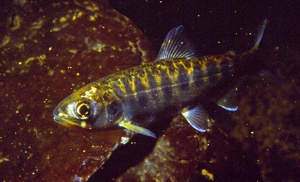
“Goat Rock and the Russian River” by W. Hsieh, CC BY 2.0
You sometimes see the phrase “All drains lead to the ocean” painted on the pavement near drainage grates in city streets, but this saying also holds true for watersheds across California. The Russian River is no exception. The river’s headwaters are located near the inland city of Willits in Mendocino County, where it begins its meandering, 110-mile journey through oak hills, valleys filled with vineyards, urban centers, and redwoods, eventually making its way to a foggy ocean outlet at Jenner.
map by CDFW Marine Region GIS Lab
Two marine protected areas (MPAs) exist on each side of the saltwater/freshwater divide where the river meets the sea: Russian River State Marine Recreational Management Area (SMRMA) and Russian River State Marine Conservation Area (SMCA). It’s no accident that these neighboring MPAs cover the boundary between the ocean and river mouth.
Although created as a statewide network, each MPA also has certain unique objectives. The Russian River SMRMA, which encompasses the estuary from the river mouth up to where Highway 1 passes over the river, restricts the take of all living things below the water but allows for waterfowl hunting. This protection helps to maintain the integrity of a rich environment that supports twenty-four species of fish, 8 species of crab, and 5 species of shrimp, as well as a large harbor seal haulout site.
 On the Pacific side of the river mouth, the Russian River SMCA spans one mile of coastline and is a little less than a square mile in total area. The take of marine resources here is limited to the recreational take of smelt and the recreational and commercial take of Dungeness crab (see CDFW’s MPA website for specific details).
On the Pacific side of the river mouth, the Russian River SMCA spans one mile of coastline and is a little less than a square mile in total area. The take of marine resources here is limited to the recreational take of smelt and the recreational and commercial take of Dungeness crab (see CDFW’s MPA website for specific details).
The protection of steelhead, Chinook salmon, and coho salmon, collectively referred to as salmonids, was a central factor in the creation of both MPAs. The Russian River is home to unique populations of Chinook and coho salmon, which are listed as threatened and endangered, respectively. The MPAs provide crucial protection for the unique lifecycle of these fish. Salmonids are anadromous – that is, they are born in freshwater streams, but then migrate and spend most of their life in the ocean, returning to the streams of their birth to reproduce and die. Their reproductive success relies on this ocean-river corridor during their journey to and from the sea.

image courtesy Internet Book Images
Russian River salmonids begin their lives after hatching in the tranquil, gravelly tributaries upriver – like those of Willow, Dry or Austin creeks. While there, they grow into tiny fish called fry. These fry feast on the creek’s resources until they grow into smolts – silvery, finger-sized fish ready for the open ocean. Prior to their exit to the ocean, these fish spend anywhere from a few weeks to a number of months in the estuary adjusting to the salinity of ocean water and feeding on the estuary’s resources. The creation of the Russian River SMRMA protects the habitat and the myriad prey the smolts rely on during this early stage in life.

CDFW photo
The Russian River SMCA was established in part to protect salmonids during another crucial point in their incredible life journey. After approximately one to two years at sea, the same salmonids return to the Russian River to reproduce. They collect outside the river’s mouth, waiting for the summer sand bar to rupture due to heavy winter rains. This waiting period makes them particularly vulnerable. Prohibiting the take of salmon in the SMCA ensures the salmonids have a fighting chance to return to their stream of origin and start the process all over again.
Adult salmon in Austin Creek. video courtesy Sonoma County Water District
Salmonid populations in the Russian River and beyond offer valuable insights into the connection between land and sea. The creation of the Russian River SMRMA and Russian River SMCA protects these connected habitats, allowing us to deepen our understanding of the importance of such places now and into the future.
Russian River State Marine Conservation Area and Russian River State Marine Recreational Management Area are two of the 124 MPAs in California’s statewide MPA Network. Please visit CDFW’s MPA website for more information, and sign up to receive updates about the MPA Management Program.
 post by Leandra Lopez, CDFW Scientific Aid
post by Leandra Lopez, CDFW Scientific Aid
Learn more about MPAs by diving into the Exploring California’s Marine Protected Areas series!

